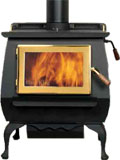Dear Umbra,
When you suggested that someone may want wood heat because it “makes you feel like a country stud,” you made an erroneous assumption — that your audience is entirely urban. Here in Skamokawa, Wash., many a mile from the nearest natural gas line, the choices are essentially wood or electricity. In September, my family installed a Blaze King wood stove, which uses a catalytic converter to convert smoke to heat. Not only does the wood burn so completely that we have not yet had to clean out any ash, but when the stove is up to temperature, there is no visible smoke emanating from the chimney — just heat waves. Moreover, the house is warm despite having to use as little as one load of wood a day. I know there is still pollution, and I know the chainsaw I use to cut the wood has a nasty two-stroke engine, but the wood has not traveled far and has required virtually no infrastructure to get here. Much of what we burn comes from the trees that periodically fall across our quarter-mile long driveway.
How about taking a look at the most efficient and nonpolluting sources of wood heat rather than dismissing all wood heat in one flip paragraph?
Rurally,
Andrew
Skamokawa, Wash.
Dearest Andrew,
I offended you with my sloppy prose. I was making no urbo-centric assumption, just casting aspersions on fireplaces, those romantic, inefficient, wood-burning holes in the wall to which the query related. Apologies. People who heat their homes with wood are indeed country studs, and any fool who wishes to argue otherwise should put their ax (or chainsaw) where their mouth is.

The King blazes. Photo: BlazeKing.com
I must say, I love the name of your stove. That Blaze King, with its catalytic converter, or catalytic combustor, is on the cutting edge of emission-friendly stove design. Just as the automobile met emission standards via a catalytic tailpipe attachment, the wood stove has come into modern times via an appendage. Wood smoke contains nitrogen oxides (smog-forming tidbits), carbon monoxide, and particulate matter. The catalytic attachment burns residual particulate matter from the wood fire, which would otherwise zip up the chimney and lower the air quality. Modern stoves must meet U.S. EPA emissions standards, and individual states also have wood-burning regulations.
One important factor in environmentally minded stove choice is to buy the right stove for your space needs. If you install a big stove for a tiny woodland hut, you’ll constantly be shutting it down to reduce the heat. The wood will burn inefficiently, aka smolder, increasing pollutants. Look for an efficient, well-built stove that will produce a hot fire no bigger than you need. The best advice I came across was to ask your local chimney sweep. Nobody knows efficiency like the guy who cleans up the mess.
Although most of us envision the traditional squat metal stove when we think about wood heating, another option is a masonry stove. These, which hail from Europe, are large constructions that surround small fireplaces. The fire burns small and hot, and the wood exhaust is worked through a secondary combustion chamber and a series of pipes and tubes, radiating throughout the stove. Burning is very complete and efficient and the heat radiates out of the stove for hours (or days, depending on how well the house is sealed). Masonry stoves are often beautiful — decorated with tile, stone, or adobe — and you can lean against them. My masonry-stove-owner friend does bemoan how long it takes for the house to heat up, though.
Here’s an interesting tidbit I found in the American Council for an Energy-Efficient Economy’s Consumer Guide to Home Energy Savings: If you’re burning sustainably harvested wood, the trees that replace the wood absorb more carbon dioxide than is created burning it.
Hearthily,
Umbra

